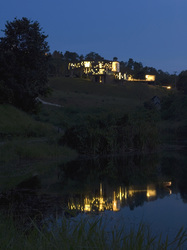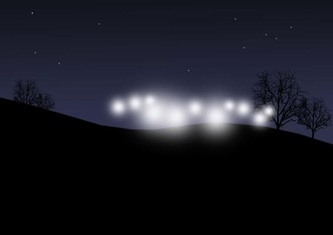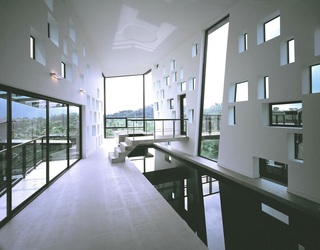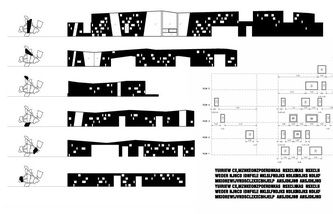Lampyris House
Formally and Programmatically the Lampyris house embodies the principal of reciprocation: that which is taken is given back in equal measure. The site is located on a remote hillside adjacent to the Khao Yai national park, affording the house very prominent views of the park by day but little or no view at night due to its complete isolation. We attempted to mediate the distinction between interior and exterior by reciprocating views enjoyed from within the house by day with nocturnal views of the house from without by night. This environmental parity is achieved by balancing what we call a picture frame effect and a lampyris effect.
Picture Frame effect: why should we assume that a bay window creates the best relation between outside and inside? Just because a partition is transparent does not necessarily mean that it will foster a less mediated relationship between interior and exterior. Plus, privileging the windows as the portal to the outside reinforces a dichotomy between wall and window, where the former pertains only to the interior and the latter to the exterior. Lampyris house changes this. Large windows are fragmented and scattered across walls in picture frame size apertures. In place of pictures, paintings and decorations that usually compensate for a wall’s plane-ness relative to its neighboring windows, we keep the frames but replace their contents with picture windows that capture vignettes of the surrounding environment. Wall and window, interior and exterior, lose their binary nature as they dematerialize into one another.
Lampyris effect: Lampyris refers to a firefly that emits a constant source of light after dusk. In our first visit to the site, we imagined the pitch darkness of the site at night, and envisioned a cluster of disembodied lights suspended—firefly-like—before the hillside’s silhouette. The picture frame effect that so successfully confounds the wall/window and interior/exterior dichotomies by day, achieves this prepossessing scene of levitating luminous orbs at night. At the same time, the house’s plan and elevations are exploded into a microcosm of interconnected programmatic units that, at once, foster circulation within and scatter the picture-frame-filled facades, swarm-like, throughout the site. To enhance this quality, interior walls are painted white while the exterior’s deep violet hue allows the house to dissolve into the evening darkness. Viewing is hereby commensurate: views out from within reciprocate views in from without; day balances night, windows balances wall, and interior balances exterior.
Picture Frame effect: why should we assume that a bay window creates the best relation between outside and inside? Just because a partition is transparent does not necessarily mean that it will foster a less mediated relationship between interior and exterior. Plus, privileging the windows as the portal to the outside reinforces a dichotomy between wall and window, where the former pertains only to the interior and the latter to the exterior. Lampyris house changes this. Large windows are fragmented and scattered across walls in picture frame size apertures. In place of pictures, paintings and decorations that usually compensate for a wall’s plane-ness relative to its neighboring windows, we keep the frames but replace their contents with picture windows that capture vignettes of the surrounding environment. Wall and window, interior and exterior, lose their binary nature as they dematerialize into one another.
Lampyris effect: Lampyris refers to a firefly that emits a constant source of light after dusk. In our first visit to the site, we imagined the pitch darkness of the site at night, and envisioned a cluster of disembodied lights suspended—firefly-like—before the hillside’s silhouette. The picture frame effect that so successfully confounds the wall/window and interior/exterior dichotomies by day, achieves this prepossessing scene of levitating luminous orbs at night. At the same time, the house’s plan and elevations are exploded into a microcosm of interconnected programmatic units that, at once, foster circulation within and scatter the picture-frame-filled facades, swarm-like, throughout the site. To enhance this quality, interior walls are painted white while the exterior’s deep violet hue allows the house to dissolve into the evening darkness. Viewing is hereby commensurate: views out from within reciprocate views in from without; day balances night, windows balances wall, and interior balances exterior.




